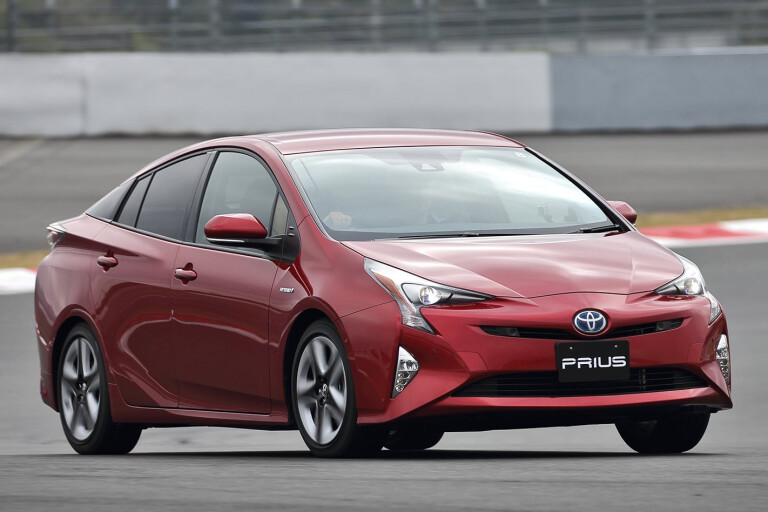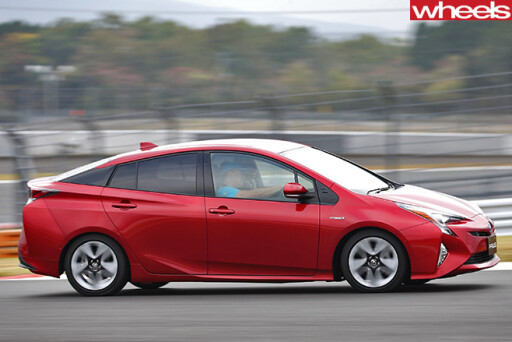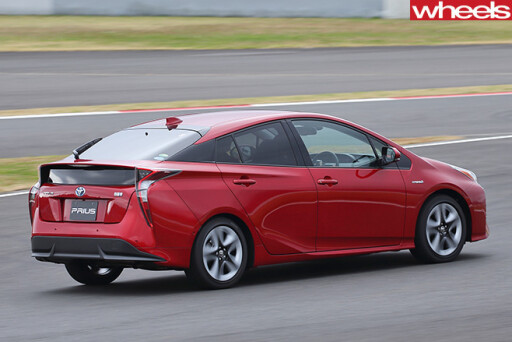
Toyota has launched the fourth-generation of its environmental poster car, the petrol-electric hybrid Prius.
WHAT IS IT?
This is generation four of the petrol-electric hybrid car launched in Australia in 2001 that most of us have, one time or another, loved to hate.
WHY WE'RE TESTING IT
Toyota is talking up this generation of the Prius, built on a new mid-size platform that will underpin a number of future platforms, as being fun to drive. Can the Toyota Prius finally hang up its cardigan?
MAIN RIVALS
Toyota Camry Atara S Hybrid, Ford Mondeo Ambiente TDCi, Mazda 6 Touring
 THE WHEELS VERDICT
THE WHEELS VERDICT
The Toyota Prius appears to be improving, losing much of what made it the automotive equivalent of a soggy Weetbix on the road. That can only be good for it.
PLUS: Dynamically more focussed; engine and CVT now a better match; brake pedal loses wooden feel; improved fuel use
MINUS: Higher use of aluminium and double-wishbone rear means it’s more expensive to make and potentially buy; doubts over lithium ion battery for Australia; no plug-in version
THE WHEELS REVIEW
TOYOTA’S hybrid technology is now almost two decades old. Over time the technology has improved, but the drab, dreary experience behind the wheel has essentially remained the same. Until now.
The fourth-generation Prius is about to arrive, and it’s shaping up to be something of a revolution. The biggest change is that it introduces the Toyota New Global Architecture that will underpin a range of as-yet unnamed mid-size models.
 The TNGA chassis uses more high-strength steel, and in the interests of saving weight the Prius now includes lighter aluminium panels for the bonnet, boot, and front crash bars.
The TNGA chassis uses more high-strength steel, and in the interests of saving weight the Prius now includes lighter aluminium panels for the bonnet, boot, and front crash bars.
There’s still the traditional Macpherson struts up front, although they feature a more laid-back angle of attack and increased camber to help distribute steering force, and their towers now are joined by a stiffening cross-brace. Down the rear is a double wishbone – the stuff of performance cars – replacing the former generation Toyota Prius' torsion beam.
Inside, the instrument cluster – now in full colour – is still offset to one side of the driver’s eyeline. The Volvo-style floating centre console is gone, replaced with a fixed one with a shallow pan shaped to nestle a mobile phone. A smarter-looking steering wheel is now round rather than the former Prius’s oddly ovoid one.
 Instead of hogging boot space, a more compact, energy-dense battery sits beneath the rear seats. The resulting larger boot can now open into the passenger cabin.
Instead of hogging boot space, a more compact, energy-dense battery sits beneath the rear seats. The resulting larger boot can now open into the passenger cabin.
According to Toyota, the Prius is all about its newfound dynamics. To explore it, we were given two low-speed laps – about four kilometres all up – of the Lexus-owned test track fronting Japan’s Fuji Speedway.
It was enough to learn that improvements to the Prius are more advanced than the awkward cosmetics. The steering is 15 percent quicker than in the model it replaces, and has decent weight despite obviously being optimised for city parking. The formerly wooden brake pedal with its extensive dead zone now has a sharper, linear feel, and the awkward lurch when the regenerative braking kicks in to sap electricity from the Prius’s kinetic energy has smoothed out to be almost imperceptible.
 Go directly against the fuel-sipping hybrid ethos and mash the pedal, and where the old engine flared on step-off to settle into an uninspired drone, the new Prius draws more torque from its electric motor to smooth out acceleration. As a result, the 1.8-litre engine can hit constant revs earlier, making it sound less desperate to win the red light drag race.
Go directly against the fuel-sipping hybrid ethos and mash the pedal, and where the old engine flared on step-off to settle into an uninspired drone, the new Prius draws more torque from its electric motor to smooth out acceleration. As a result, the 1.8-litre engine can hit constant revs earlier, making it sound less desperate to win the red light drag race.
The throttle-dulling eco mode is no more, with just a default setting supplemented by a power mode that, upon the push of a dash-mounted button, changes the dash to an angry neon red.
The size of some of the components making up the hybrid drivetrain have shrunk by about a third, and the seats are mounted lower in the chassis, moving the centre of gravity down and greatly reducing the elephant-on-roller-skates feel of the outgoing Prius.
 Pushing the hybrid through a slalom on the test track revealed a hint of keenness for corners. A limiting factor are the 17-inch Toyo Nanoenergy tyres, which squeal in protest even at moderate cornering speeds.
Pushing the hybrid through a slalom on the test track revealed a hint of keenness for corners. A limiting factor are the 17-inch Toyo Nanoenergy tyres, which squeal in protest even at moderate cornering speeds.
As yet, there’s no official fuel use figure for the Prius, although it could fall to as little as 2.5L/100km, helped by the electric motor that can now coast the Prius at speeds of up to 100km/h.
WEIGHT FOR IT
THIS generation of Prius will again be available with either a heavier, cheaper nickel metal hydride battery, or a lighter, more expensive one. However, the lighter battery will only be used in markets where the 15kg saving improves fuel economy to meet strict emissions targets – think North America and Japan, not Australia. The new Prius uses more lightweight aluminium than the model it replaces, at up to double the cost of steel parts.
SPECS
Model: Toyota Prius
Engine: 1797cc 4cyl, dohc, 16v + electric motor
Max power: Engine 72kW@5200rpm/motor 53kW
Max torque: Engine 142Nm@3600rpm/motor 163Nm
Transmission: CVT
Weight: N/A
0-100km/h: N/A
Fuel economy: 2.4L/100km (estimated)
Price: $35,000 (estimated)
On sale: Q1 2015

COMMENTS